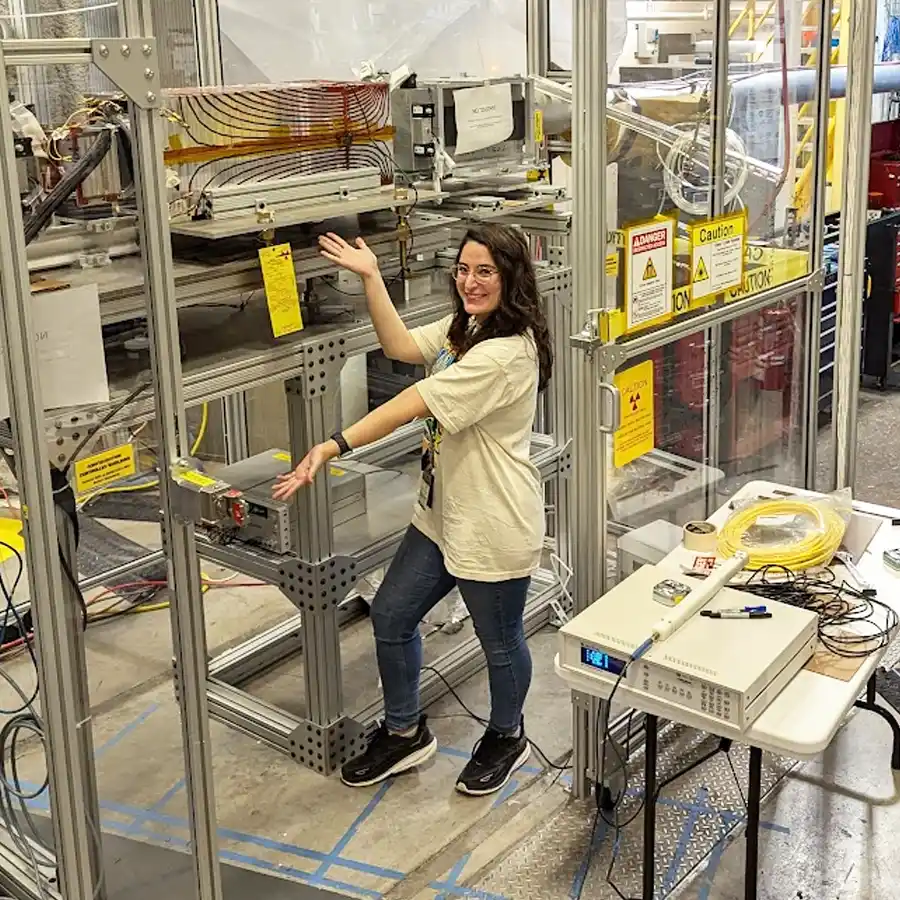Another SCGSR Award for UT Physics
Rebecca Godri isn’t afraid of the hard work needed to test the Standard Model of Physics. As the department’s newest student selected for the prestigious Department of Energy (DOE) Office of Science Graduate Student Research (SCGSR) program, she’s won financial support to pursue this effort at Oak Ridge National Laboratory (ORNL).
Looking for new physics
As part of UT’s fundamental neutron physics group, Godri investigates the weak force, one of the four fundamental interactions in nature. She’s working on the Nab experiment at ORNL; a project designed to discover the nuances of neutron beta decay, a weak process.
A free (unbound) neutron is unstable: it will decay into a proton, electron, and antineutrino. Professor Nadia Fomin, one of Godri’s advisors, explained that “As experimentalists, we can ‘observe’ the neutron spin, momenta of the charged particles, and the angles between them. While the antineutrinos are detectable, the efficiency is very low, and we can get all the necessary information from basic principles of energy and momentum conservation.”
The Nab experiment will make precise determinations of “little a” and “little b,” decay correlation parameters of neutron beta decay. These determinations provide a stringent test for physics beyond the Standard Model.
Flipping the Spin
As small as protons, electrons, and antineutrinos are, the Nab experiment requires mighty tools to study them. Godri is working at the Fundamental Neutron Physics Beamline (FnPB) at the ORNL Spallation Neutron Source, a state-of-the-art facility that directs a powerful neutron stream down beamlines for instruments purpose-built for specific kinds of measurements. As their name implies, neutrons have no positive or negative charge. They do, however, have spin, a magnetic property that points them in certain direction. When neutrons decay, their speed, energy, and direction can give scientists critical information. The FnPB is unique in that can support different experiments with different full-scale apparatus, such as Nab.
Godri’s work, which she recently presented at an American Physical Society meeting, is getting neutrons to reveal more clues about the weak interaction in physics. To do that she’s measuring the residual polarization of the neutron beam at the FNPB and characterizing the Nab experiment’s spin flipper—a device that lets scientists control the neutron’s spin. She works with both Fomin at UT and Chenyang Jiang, a research scientist in ORNL’s Neutron Technologies Division.
While some may find all the preparation tedious, Godri said she enjoys both the groundwork and the payoff.
“The hands-on work is exciting,” she said. “My favorite part is being able to get data from the measurements we’ve spent months preparing for!”
An Easy Decision
Godri earned a bachelor’s degree in physics from the University of Tennessee at Chattanooga in 2021 and started her graduate studies in Knoxville that fall. She finished a master’s in physics last year and is working toward a PhD.
UT’s nuclear physics research opportunities made it an obvious choice for her graduate studies.
“Nadia’s research at ORNL aligned with my research interests post-undergrad, so UT was an easy decision,” she said. Godri’s SCGSR award is the 14th for UT Physics since 2016 and the fifth this year. She’s part of the latest cohort, comprising 62 PhD students from 24 states

